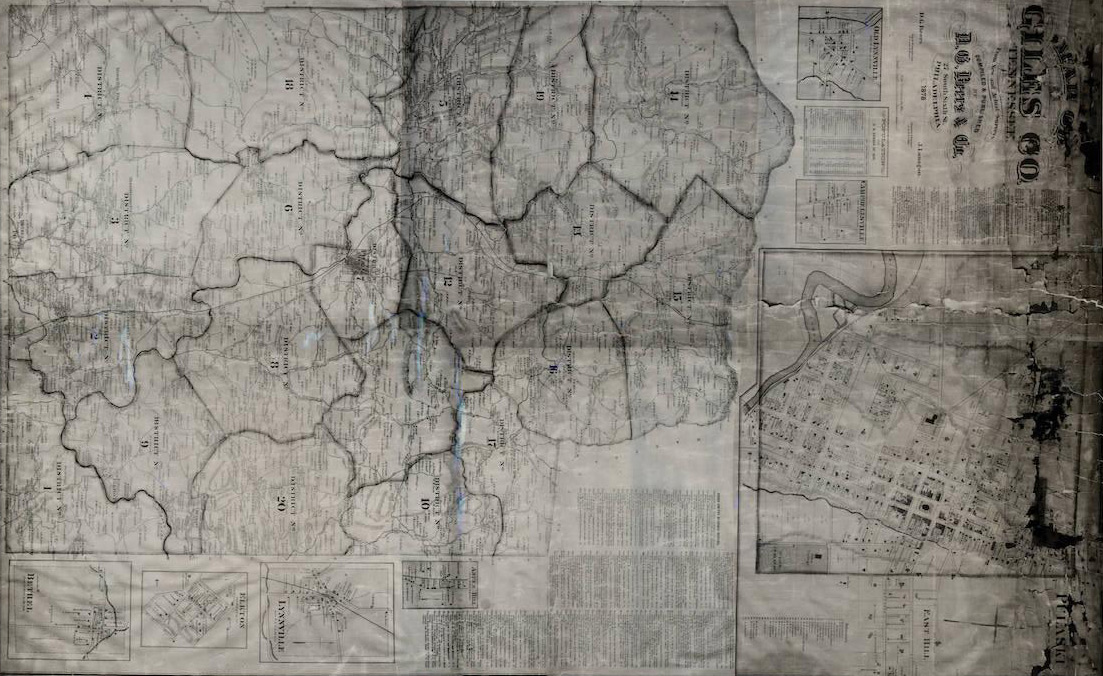This website uses cookies so that we can provide you with the best user experience possible. Cookie information is stored in your browser and performs functions such as recognising you when you return to our website and helping our team to understand which sections of the website you find most interesting and useful.
Giles County’s History is Preserved in the Archives
After years of painstaking dedication, county records from 1810 to 1900, including deeds, wills, marriages and records from the Chancery, County and Circuit Courts were cleaned, indexed and archived for public research. Records include: Marriage Records (1865-2000), Wills (1810-1940), Chancery Court Records (1810-1900), Deeds (1810-1896), County Court Records, Circuit Court Records, Obituary and Cemetery books (1810-1986), Genealogical Vertical Files. In addition, researchers can search microfilm of Giles County’s newspapers and other records.
Many families have contributed copies of their detailed genealogical research to the Giles County Archives to enhance the research experience. A copier is also available for visitors.
Important links:
- Download Index of Record Holdings
- Selected Bibliography of Giles History Publications
- Guide to Giles Genealogical Resources
- Cemetery List (Partial)

Barbara Garrett Nicolson,
Giles County Archives
Email: BNicolson@gilescountytn.gov
Location: 211 South Cedar Lane, Pulaski, TN 38478
Phone: 931-363-8434
Mail: 211 South Cedar Lane, Pulaski, TN 38478
Hours: M–F, 8 a.m. – 4 p.m.
Early History of Giles County, Tennessee
Giles County was created by the Tennessee General Assembly when, at the specific urging of General Andrew Jackson, they passed “AN ACT TO ESTABLISH A COUNTY SOUTH OF MAURY COUNTY, AND NORTH OF THE SOUTHERN BOUNDARY OF THE STATE” on Nov. 14, 1809. The County is named for William Branch Giles, who during his tenure in the U.S. House of Representatives, had strongly supported the 1796 statehood of Tennessee. Giles County had originally been a part of North Carolina.
The Legislature specified a group of individuals who became Commissioners and charged them with identifying 100 acres of land in the center of the County to become the County seat. Ultimately a tract of land on the Shoals of Richland Creek, now Pulaski. The County Seat is named a Polish Count who died at the Battle of Savannah during the Revolutionary War in 1779. These commissioners were John Dickey, Jacob Baylor, Somersett Moore, Charles Neiley, Robert Steele, Nathaniel Moody, William Phillips, Benjamin Long, Thomas Westmoreland, David Porter and Maximillian H. Buchanan. Thomas H. Stewart was appointed Judge and Amos Balch became attorney general of the Fourth Judicial Circuit, embracing Giles County.
Settlers were allowed to begin legally occupying the land after the 1806 treaty with the Cherokee was signed. The first settlements were Elkton and Prospect and later Lynn Creek, Campbellsville, Pulaski, Bodenham, Crosswater, Aspen Hill and Blooming Grove. Today, Pulaski, Lynnville Minor Hill, Ardmore and Elkton are Giles County’s incorporated communities. The County Seat is Pulaski where three other courthouses were used before the current courthouse was erected in 1909. Arguably the most beautiful courthouse in Tennessee, it is listed in the National Register of Historic Places.
In the foyer of the neoclassical structure are busts of three of Giles County’s native citizens who became Tennessee’s governors: Aaron V. Brown, Neill Smith Brown and John C. Brown. The trio of Browns who served as Governors were of different parties and reflect the history of Giles County leading into the Civil War. Aaron Brown (1795-1859) served in both the Tennessee House of Representatives and the Tennessee State Senate before being elected to the U.S. House of Representatives. He was elected Governor as a Democrat in 1845. At the time, terms of office for Governor were two years, and he served until 1847 when he was defeated by another Giles County Brown (no relation), Neill S. Brown who was a Whig.
It was Aaron Brown who authored the Tennessee Platform which sought to expand slavery into the Territories should a slaveholder travel with his “property” into non-slaveholding territories. This was seen as something of a compromise in that territories may become non-slaveholding, but there would be a recognition of slaveholders who might move or travel to these new spaces with slaves in tow. “Under the Tennessee platform, the slaveholder is free to go into the Territories with his property. He may claim the same protection from his government that it is bound to afford him anywhere else within its jurisdiction. Its hands are bound not to injure him, nor can the Territorial authorities discriminate against him or his property. Ought not this satisfy all parties desirous of harmony? . . . It will be seen that wise and temperate counsels will in the end prevail, and the Democratic party may be united upon principles at once just and fraternal,” Aaron V. Brown wrote.
While Aaron Brown’s Tennessee Platform was introduced at a divided Democratic Convention, it was never voted on. The presence of the Nashville and Decatur Railroads made Giles County a hub of the Civil War. While there were no major battles fought in Giles County, it was occupied by Federal Troops for most of the war. Many Giles County men and boys served in the Civil War, with a number of them losing their lives on the battlefield or in prison camps. In 1863, 21- year- old Confederate Sam Davis, a member of Coleman’s Scouts, was condemned and executed at Pulaski under the supervision of Grenville Dodge. Sam Davis’ last words were “If I had a thousand lives, I would lose them all here before I would betray my friend or the confidence of my informer.” Davis’ statue stands today on the south side of the Pulaski square.
In all, Giles County sent four Generals to the Confederacy: John C. Brown (later the Governor of Tennessee), G.W. Gordon, John Adams and Preston Smith. By the end of the War, more than 2,000 men of Giles County had fought as Confederate soldiers. Following the War, John C. Lester, James R. Crowe, John Kennedy, Calvin Jones, Richard R. Reed and Frank O. McCord, established a secret society that rapidly developed a reputation for violence and intimidation as it spread across Tennessee. Pulaski would forever be known as the birthplace of the Ku Klux Klan though the original founders denounced its violent transformation and disbanded by 1869.
In recent years the Ku Klux Klan has attempted to host marches and celebrations in Pulaski. These efforts have met strong resistance from the community. Education in Giles County includes an early commitment to higher education. Pulaski Academy, later called Wurtenburg and still later, Giles College, was the County’s first. In 1872, in honor of his daughter, Victoria, Thomas Martin founded Martin Methodist College. The campus stands today as a co-educational, four year university and is a part of the University of Tennessee system, University of Tennessee Southern.
C.A. Craig, a founder of the former National Life and Accident Insurance Company, donated the Giles County Library, which is run by a private board and is funded from public and private donations, grants and appropriations. The library’s collection includes an extensive genealogy room and an historical museum owned by the Giles County Historical Society. The Sam Davis Museum, organized by the Daughters of the Confederacy, a Civil War Museum erected at the site of Davis’ hanging is also operated by the Giles County Historical Society. The African-American architectural firm in the United States, McKissack and McKissack, has its roots in Giles County as its founders were born in Pulaski and started their design business here. They were carrying forth the legacy of their father, Moses McKissack, who was a master builder. Many homes and commercial businesses were built by McKissack and his six sons. The designed Bridgeforth School, a modern, centrally-located high school for African-American students, which was built in 1927 with funding from the Rosenwald Fund.
Protecting its history, Giles County has more than 100 properties listed on the National Register as well as several National Register historic districts. Giles County is also the birthplace of two nationally known writers, John Crowe Ransom and Donald Davidson. Davidson and Ransom were associated with the group of poets at Vanderbilt University in the 1920s known as the Fugitives and an additional group in the 1930s, The Agrarians. Ransom is widely recognized as the unofficial leader of both groups. The participants emerged what is now viewed in literary circles as the Southern Renaissance. While the writers ignored the issue of slavery, they published a now famous manifesto nostalgic defense of life in the South, “ I’ll Take My Stand: The South and the Agrarian Tradition,” in 1930.
WWI & Spanish American War Business License Affidavits, Giles County, Tennessee
A collection of records, WWI Soldiers and Other Veterans, was discovered in file cabinets in the back of closets in our courthouse in 2020. This is a relatively small collection and the paper it is printed on is very brittle. The Giles County Archivists, Barbara Garrett Nicolson and Clara Parker, felt it important to flatten, surface clean, sleeve in mylar and make available online, these documents, so that they may be viewed by the public at large. Click here to explore our collection.



